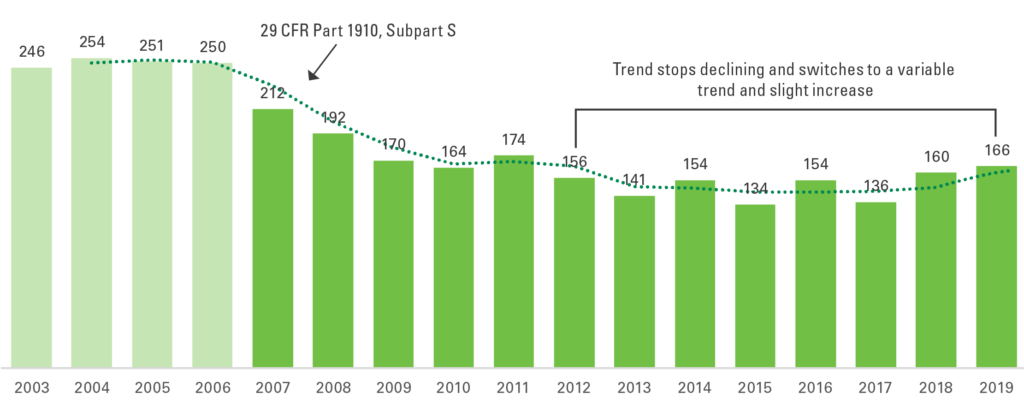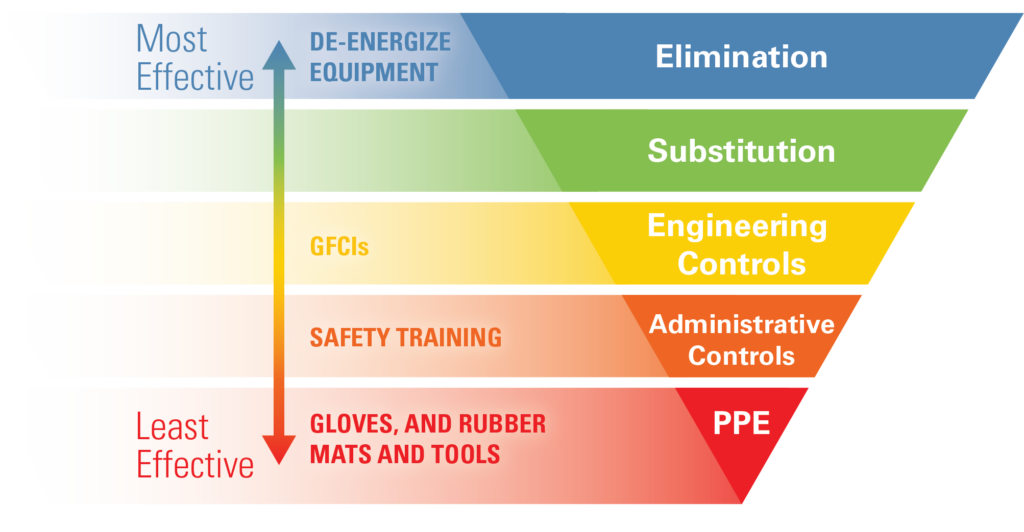Why GFCIs, Prevention through Design, Need Greater Prioritization
By Tim Piemonte & Rachel Metea, Contributors
Electrical shock is incredibly dangerous. Not only is it dangerous, but it is also a common occurrence where resulting injuries—if not fatal—can lead to lifelong complications.
More than 90 % of electrical fatalities among US workers are due to electrical shock [1]. This number does not even include the substantial proportion of injuries and fatalities that are often misclassified under a different cause of death.
Oftentimes, electrical hazards can easily be designed out or controlled with the right equipment. This article will discuss why Prevention through Design (also commonly called safety by design) is the best way to ensure nobody is injured or killed while on the job. This article is part of a bigger report published by Littelfuse, which is available here.
Why Electrical Shock Incidents Are More Serious Than the Data Reflects
No one is immune from an electrical incident, regardless of their trade. According to data from OSHA, 64 % of all electrical fatalities occur in non-electrical occupations [2]. Thus, companies still have a high risk of fatal incidents from electrical shock occurring regardless of whether mandates require electrical work to be done by qualified workers only.
Industry reports say that electrical fatalities have steadily declined since NFPA 70E became required. This is misleading because it is based on a linear trendline, which is not the best way to understand data that fluctuates from year to year. If we use a 2-year sliding average of these fatality rates, we will see that the electrical fatality rate among workers has nearly flatlined since this rate sharply dropped in 2007.
In 2007, OSHA published 29 CFR Part 1910, subpart S, which was the first revision to OSHA’s general industry electrical standard in 25 years. The basis of the updates was NFPA 70E-2000 (the previous version used the 1979 edition of NFPA 70E and safety design requirements for electrical installations, such as expanded requirements for ground-fault circuit interrupters (GFCI) protection of temporary wiring used for maintenance and repair purposes (§ 1910.304(b)(3)(ii)) [3]. Upon OSHA’s requirement for companies to follow better electrical safety designs, the number of electrical fatalities sharply dropped.
In the years following this sharp drop—after most states adopted the new safety standard—the rate of fatalities began to flatline. Thanks to the addition of GFCI requirements in certain applications, the fatality rate is not as high as it once was. However, the current fatality rate shows us that there is still more work to be done—there are more applications where GFCIs can be applied and save lives but are yet to be required by NEC.
When Incidents are Prevalent, a Better Approach is Necessary
Most companies’ current electrical safety approach is not foolproof, particularly among those that rely on PPE and administrative controls (such as safety training). While well intentioned, these methods are prone to human error.
Safety professionals are oftentimes at the forefront of a company’s safety approach, which includes electrical safety. Most safety professionals, however, do not have electrical backgrounds.
This can have two subsequent effects on the company’s electrical safety: 1) it shifts the facility’s electrical safety approach to focus on safety training and PPE rather than Prevention through Design; and 2) the training’s electrical safety component usually becomes lockout/tagout topics, ignoring topics about how to ensure safety in areas that may have long, worn cables or wet environments, for example.
Studies find that even trained workers have a poor ability to recognize electrical hazards. Untrained workers—especially those who work in wet conditions or places where flexible cables are used—are even more at risk. Many studies demonstrate that safety training usually does not adequately cover electrical safety, and of the topics it includes, workers usually do not retain that information.
Why Prevention through Design, GFCIs, are More Surefire than Human-Based Methods
The Hierarchy of Controls
The hierarchy of controls starts with the most effective and moves down to the least effective safety measure. Not all hazards can be eliminated, but the idea is that the closer you get to the top, the safer workers will be.
The hierarchy of control’s methods are:
- Elimination: Physically remove the hazard
- Substitution: Replace the hazard
- Engineering controls: Isolate people from the hazard
- Awareness: Inform people of possible hazards
- Administrative controls: Change the way people work
- Personal protective equipment: Protect the worker with PPE
NFPA 70E follows the model of the hierarchy of controls. The standard establishes the de-energization of energy sources as the preferred approach to working on or around electrical hazards and emphasizes that PPE should solely be relied upon as a last resort (or an extra layer of protection).
Ground-Fault Circuit Interrupters (GFCIs)
The NEC requires GFCI protection in some specific applications, but there are many more hazardous areas where GFCIs should be applied.
For example, control panels that need to be routinely serviced or troubleshot qualified technicians who must frequently perform live work as a result. The installation of a GFCI in this type of circuit will protect these technicians if they fail to properly follow OSHA 1910.333—Selection and use of work practices. Since a company knows its workers will be frequently working on this piece of equipment while it is energized, they can add GFCIs to ensure no electrical shock incidents occur in the future.
Other examples of places where GFCIs are essential to safety but may not be mandated by electrical codes include:
- Permanently connected equipment in wet or damp areas
- Plug and cord connected equipment in dry but extreme or harsh indoor environments (such as industrial, manufacturing where there is a high level of heat, dirt, and dust)
- Temporary power receptacles other than single-phase 125 volts, 30 amperes and below.
- Any similar permanently connected or plug-and-cord application that is greater than 208 volts (Class C and D SPGFCI applications).
When an electrical designer knows they must put a control panel in a wet environment, they should consider installing a GFCI to protect the main or a portion of the circuits in that control panel. GFCIs can greatly impact safety when used in control panels where people perform work, along with other places that often require frequent troubleshooting.
If NEC were to require companies to use GFCIs in these applications, the electrical fatality rate may begin to decline as it did when electrical codes were ramped up. GFCIs save lives, so companies should continue to apply them wherever they are applicable regardless of whether they are mandated or not.
Electrical workers often become complacent and take unsafe actions for a variety of reasons. Sometimes it is because they think they know better, while other times it is due to the nature of the task. Electrical safety can easily be missed among workers who are using portable equipment since they are often not provided with adequate safety training, or because the equipment was not protected with a GFCI.
The best Prevention through Design methods involve more than system safety controls—they remove the human interaction element altogether. Out-of-sight, out-of-mind methods, such as GFCIs, operate independently of workers, so they are always safe from electrical shock. If a worker irresponsibly takes their gloves off while using tools, or a safety training course failed to mention the hazards of frayed cables (or if no one noticed the cables are frayed—it happens), workers will still be safe if GFCIs are present. Even with the best safety training and top-of-the-line PPE, these situations could otherwise be fatal.
Oftentimes, the most difficult part of widespread issues is in recognizing that you are among those who can do better. It is not seeing the problem—it is recognizing that you are likely a part of it. The most critical step a company can take to ensure its workers are not seriously injured or killed is to prioritize Prevention through Design. Without proactively taking this step, someone within their company could someday become another electrical fatality statistic. ESW
For more information, or to read the full report, visit https://www.littelfuse.com/marketing-pages/industrial/papers/electrical-shock-deadly-and-prevalent.aspx.
Tim Piemonte is a Vertical Market Manager at Littelfuse, a global manufacturer of circuit protection and control technologies. He has over 11 years of experience in the electrical industry, including six years of field service and power system analysis at GE, where he focused primarily on commercial and industrial power distribution. Piemonte is a member of IEEE, IAEI, NFPA, and received his B.S. in Electrical Engineering from Rensselaer Polytechnic Institute in 2010.
Rachel Metea is the technical writer at Littelfuse. She holds a BA in communications and an MA in journalism from DePaul University. Metea is a member of IEEE.
[1] Census of Fatal Occupational Injuries (CFOI), US Department of Labor, Bureau of Labor Statistics, 2019. [Online] Available: https://www.bls.gov/iif/oshcfoi1.htm
[2] B. Brenner, J.C. Cawley and D. Majano, “Electrically Hazardous Jobs in the US,” IEEE Transactions on Industry Applications, to be published. DOI 10.1109/TIA.2020.2980221.
[3] Department of Labor, Federal Registrar, 29 CFR Part 1910, Subpart S. Available from: https://www.osha.gov/sites/default/files/laws-regs/federalregister/2007-02-14.pdf
Share on Socials!
How to Prevent and Respond to Arc Flash Injuries
The Art of the Layering System
Five Ways to Know You’re Getting a Complete Arc Flash Study
Leaders in Electrical Safety
• Aramark
• Bowtie Engineering
• Enespro
• Ericson
• I-Gard Corporation
• IRISS
• KERMEL, INC.
• Lakeland Industries
• MELTRIC Corporation
• National Safety Apparel
• National Technology Transfer
• Oberon
• Saf-T-Gard
• SEAM Group
Subscribe!
Sign up to receive our industry publications for FREE!









